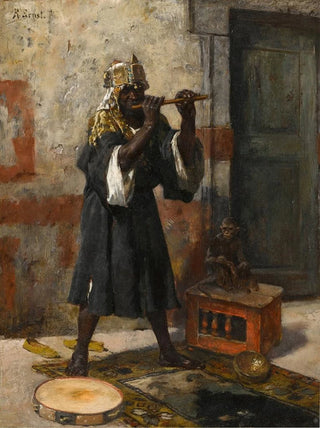Art print | The Flute Player - Rudolf Ernst


View from behind

Frame (optional)
In the fascinating world of art, some works manage to capture not only the eye but also the soul. "The Flute Player" by Rudolf Ernst is one of those creations that transcend the mere frame to offer an immersive experience. This painting evokes a suspended moment in time, where music seems to rise from the pigments to enchant the viewer's mind. The scene depicts a musician immersed in his art, surrounded by a rich and evocative setting, inviting deep contemplation. The magic of this piece lies in its ability to transport the viewer to a world where melody and color intertwine, creating a visual and auditory harmony.
Style and uniqueness of the work
Rudolf Ernst's style is characterized by striking realism, where every detail is carefully crafted to bring his characters to life. In "The Flute Player," the artist manages to capture not only the physical features of the musician but also the very essence of his art. The nuances of light and shadow, the delicate textures of the clothing, as well as the focused expression of the flutist, testify to exceptional craftsmanship. Ernst skillfully plays with light to create an intimate atmosphere, immersing the viewer in an almost tangible ambiance. The composition, balanced and dynamic, guides the eye toward the musician while hinting at the surrounding elements that enrich the visual storytelling. Thus, each brushstroke contributes to weaving a story, inviting a deeper exploration of the artwork.
The artist and his influence
Rudolf Ernst, born in 1854 in Vienna, is an artist whose work is rooted in the tradition of realism and romanticism. His career, marked by stays in the Orient, profoundly influenced his style and thematic choices. By incorporating exotic elements and scenes of everyday life, Ernst was able to create a unique atmosphere that is his own. His interest in music, in particular, is reflected in several of his works, where he explores the relationship between visual art and other forms of expression. The impact of his work is felt beyond his era, inspiring many contemporary artists.

Matte finish

View from behind

Frame (optional)
In the fascinating world of art, some works manage to capture not only the eye but also the soul. "The Flute Player" by Rudolf Ernst is one of those creations that transcend the mere frame to offer an immersive experience. This painting evokes a suspended moment in time, where music seems to rise from the pigments to enchant the viewer's mind. The scene depicts a musician immersed in his art, surrounded by a rich and evocative setting, inviting deep contemplation. The magic of this piece lies in its ability to transport the viewer to a world where melody and color intertwine, creating a visual and auditory harmony.
Style and uniqueness of the work
Rudolf Ernst's style is characterized by striking realism, where every detail is carefully crafted to bring his characters to life. In "The Flute Player," the artist manages to capture not only the physical features of the musician but also the very essence of his art. The nuances of light and shadow, the delicate textures of the clothing, as well as the focused expression of the flutist, testify to exceptional craftsmanship. Ernst skillfully plays with light to create an intimate atmosphere, immersing the viewer in an almost tangible ambiance. The composition, balanced and dynamic, guides the eye toward the musician while hinting at the surrounding elements that enrich the visual storytelling. Thus, each brushstroke contributes to weaving a story, inviting a deeper exploration of the artwork.
The artist and his influence
Rudolf Ernst, born in 1854 in Vienna, is an artist whose work is rooted in the tradition of realism and romanticism. His career, marked by stays in the Orient, profoundly influenced his style and thematic choices. By incorporating exotic elements and scenes of everyday life, Ernst was able to create a unique atmosphere that is his own. His interest in music, in particular, is reflected in several of his works, where he explores the relationship between visual art and other forms of expression. The impact of his work is felt beyond his era, inspiring many contemporary artists.






